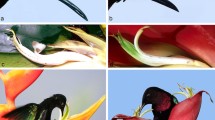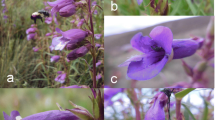Abstract
Floral phenotype and pollination system of a plant may be influenced by the abiotic environment and the local pollinator assemblage. This was investigated in seven plant–hummingbird assemblages on the West Indian islands of Grenada, Dominica and Puerto Rico. We report all hummingbird and insect pollinators of 49 hummingbird-pollinated plant species, as well as six quantitative and semi-quantitative floral characters that determine visitor restriction, attraction and reward. Using nonmetric multidimensional scaling analysis, we show that hummingbird-pollinated plants in the West Indies separate in floral phenotypic space into two gradients—one associated with the abiotic environment and another with hummingbird size. Plants pollinated by large, long-billed hummingbirds had flowers with long corolla tube, large amounts of nectar and showy orange-red colouration. These attracted few or no insect species, whereas plants pollinated by small, short-billed hummingbirds were frequently pollinated by insects, particularly lepidopterans. The separation of plants related to environmental factors showed that species in the wet and cold highlands produced large amounts of dilute nectar, possessed no or a weak odour, and were associated with few insects, particularly few hymenopterans, compared to plants in the dry and warm lowlands. The most specialised hummingbird-pollinated plants are found in the West Indian highlands where they are pollinated by mainly large, long-billed hummingbirds. At the other extreme, highly generalised plants growing in the dry and warm lowlands are pollinated by small, short-billed hummingbirds and numerous insect species. This illustrates that, even within the hummingbird-pollinated flora, pollination syndrome and the degree of specialisation may vary tremendously depending on pollinator morphology and environment.


Similar content being viewed by others
References
Aizen MA (2003) Down-facing flowers, hummingbirds and rain. Taxon 52:675–680
Aizen MA, Ezcurra C (1998) High incidence of plant–animal mutualisms in the woody flora of the temperate forest of southern South America: biogeographical origin and present ecological significance. Ecol Aust 8:217–236
Araujo AC, Sazima M (2003) The assemblage of flowers visited by hummingbirds in the “capões” of Southern Pantanal, Mato Grosso do Sul, Brasil. Flora 198:427–435
Arizmendi MDC, Ornelas JF (1990) Hummingbirds and their floral resources in a tropical dry forest in Mexico. Biotropica 22:172–180
Arroyo MTK, Primack R, Armesto J (1982) Community studies in pollination ecology in the high temperate Andes of Central Chile. I. Pollination mechanisms and altitudinal variation. Am J Bot 69:82–97
Baker HG (1975) Sugar concentrations in nectars from hummingbird flowers. Biotropica 7:37–41
Bawa KS (1990) Plant–pollinator interactions in tropical rain forests. Annu Rev Ecol Syst 21:399–422
Bleiweiss R (1998) Origin of hummingbird faunas. Biol J Linn Soc 65:77–97
Bolton AB, Feinsinger P (1978) Why do hummingbird flowers secrete dilute nectars? Biotropica 10:307–309
Bradshaw HD, Schemske DW (2003) Allele substitution at a flower colour locus produces a pollinator shift in monkeyflowers. Nature 426:176–178
Bradshaw HD, Wilbert SM, Otto KG, Schemske DW (1995) Genetic mapping of floral traits associated with reproductive isolation in monkeyflowers (Mimulus). Nature 376:762–765
Brown JH, Bowers MA (1985) Community organization in hummingbirds: relationship between morphology and ecology. Auk 102:251–269
Carpenter FL (1979) Competition between hummingbirds and insects for nectar. Am Zool 19:1105–1114
Castellanos MC, Wilson P, Thomson JD (2004) “Anti-bee” and “pro-bird” changes during the evolution of hummingbird pollination in Penstemon flowers. J Evol Biol 17:876–885
Cruden RW (1972) Pollinators in high-elevation ecosystems: relative effectiveness of birds and bees. Science 176:1439–1440
Dalsgaard B, Hilton GM, Gray GAL, Aymer L, Boatswain J, Daley J, Fenton C, Martin J, Martin L, Murrain P, Arendt WJ, Gibbons DW, Olesen JM (2007) Impacts of a volcanic eruption on the forest bird community of Montserrat, Lesser Antilles. Ibis 149:298–312
Dalsgaard B, Martín González AM, Olesen JM, Timmermann A, Andersen LH, Ollerton J (2008) Pollination networks and functional specialization: a test using Lesser Antillean plant-hummingbird assemblages. Oikos 117:789–793
Devoto M, Medan D, Norberto NH (2005) Patterns of interaction between plants and pollinators along an environmental gradient. Oikos 109:461–472
Devoto M, Montaldo NH, Medan D (2006) Mixed hummingbird: long-proboscid-fly pollination in “ornithophilous” Embothrium coccineum (Proteaceae) along a rainfall gradient in Patagonia, Argentina. Aust Ecol 31:512–519
Elberling H, Olesen JM (1999) The structure of a high latitude plant-flower visitor system: the dominance of flies. Ecography 22:314–323
Faegri K, van der Pijl L (1979) The principles of pollination ecology. Pergamon, Oxford
Feinsinger P, Colwell RK (1978) Community organization among neotropical nectar-feeding birds. Am Zool 18:779–796
Feinsinger P, Swarm LA (1982) “Ecological Release”, seasonal variation in food supply, and the hummingbird Amazilia tobaci on Trinidad and Tobago. Ecology 63:1574–1587
Feinsinger P, Wolfe JA, Swarm LA (1982) Island ecology: reduced hummingbird. Diversity and the pollination biology of plants, Trinidad and Tobago, West Indies. Ecology 63:494–506
Fenster CB, Armbruster WS, Wilson P, Dudash MR, Thomson JD (2004) Pollination syndromes and floral specialization. Annu Rev Ecol Evol Syst 35:375–403
Fumero-Cabán JJ, Meléndez-Ackerman EJ (2007) Relative pollination effectiveness of floral visitors of Pitcairnia angustifolia (Bromeliaceae). Am J Bot 94:419–424
Hingston AB, Mcquillan PB (2000) Are pollination syndromes useful predictors of floral visitors in Tasmania? Aust Ecol 25:600–609
Hurlbert AH, Hosoi SA, Temeles EJ, Ewald PW (1996) Mobility of Impatiens capensis flowers: effect on pollen deposition and hummingbird foraging. Oecologia 105:243–246
Janzen DH (1973) Sweep samples of tropical foliage insects: effects of seasons, vegetation types, elevation, time of day, and insularity. Ecology 54:687–708
Johnson SD, Steiner KE (2000) Generalization versus specialization in plant pollination systems. Trends Ecol Evol 15:140–143
Kay KM, Schemske DW (2003) Pollinator assemblages and visitation rates for 11 species of Neotropical Costus (Costaceae). Biotropica 35:198–207
Kessler M, Krömer T (2000) Patterns and ecological correlates of pollination modes among bromeliad communities of Andean forests in Bolivia. Plant Biol 2:659–669
Kodric-Brown A, Brown JH, Byers GS, Gori DF (1984) Organisation of a tropical island community of hummingbirds and flowers. Ecology 65:1358–1368
Krömer T, Kessler M, Herzog SK (2006) Distribution and flowering ecology of Bromeliads along two climatically contrasting elevational transects in the Bolivian Andes. Biotropica 38:183–195
Lack D (1973) The number of species of hummingbirds in the West Indies. Evolution 27:326–337
Linhart YB, Feinsinger P (1980) Plant-hummingbird interactions: effects of island size and degree of specialization on pollination. J Ecol 68:745–760
Mayfield MM, Waser NM, Price MV (2001) Exploring the ‘most effective pollinator principle’ with complex flowers: bumblebees and Ipomopsis aggregata. Ann Bot 88:591–596
McCune B, Mefford MJ (2006) PC-ORD. Multivariate analysis of ecological data. Version 5.10 MjM Software, Gleneden Beach, OR
Medel R, Valiente A, Botto-Mahan C, Carvallo G, Pérez F, Pohl N, Navarro L (2007) The influence of insects and hummingbirds on the geographical variation of the flower phenotype in Mimulus luteus. Ecography 30:812–818
Michener CD (2000) The bees of the world. The Johns Hopkins University Press, Baltimore
Montgomerie RD (1984) Nectar extraction by hummingbirds: response to different floral characters. Oecologia 63:229–236
Myers N, Mittermeier RA, Mittermeier CG, da Fonseca GAB, Kent J (2000) Biodiversity hotspots for conservation priorities. Nature 403:853–858
Nattero J, Cocucci AA (2007) Geographical variation in floral traits of the tree tobacco in relation to its hummingbird pollinator fauna. Biol J Linn Soc 90:657–667
Olesen JM, Jordano P (2002) Geographic patterns in plant–pollinator mutualistic networks. Ecology 83:2416–2424
Olesen JM, Eskildsen LI, Venkatasamy S (2002) Invasion of pollination networks on oceanic islands: importance of invader complexes and endemic super generalists. Divers Distrib 8:181–192
Ollerton J, Watts S (2000) Phenotype space and floral typology: towards an objective assessment of pollination syndromes. Nor Vidensk Akad I. Mat-Naturvitensk Klasse Avh Ny Ser 39:149–159
Ollerton J, Killick A, Lamborn E, Watts S, Whiston M (2007) Multiple meanings and modes: on the many ways to be a generalist flower. Taxon 56:717–728
Ollerton J, Alarcón R, Waser NM, Price MV, Watts S, Cranmer L, Hingston A, Peter C, Rotenberry J (2009) A global test of the pollination syndrome hypothesis. Ann Bot (in press)
Pleasants JM, Waser NM (1985) Bumblebee foraging at a “hummingbird” flower: reward economics and floral choice. Am Midl Nat 114:283–291
Primack RB, Inouye DW (1993) Factors affecting pollinator visitation rates: a biogeographic comparison. Curr Sci 65:257–262
Proctor M, Yeo P, Lack A (1996) The natural history of pollination. Timber, Portland, OR
Pyke GH, Waser NM (1981) The production of dilute nectars by hummingbird and honeyeater flowers. Biotropica 13:260–270
Rathcke BJ (2000) Hurricane causes resource and pollination limitation of fruit set in a bird-pollinated shrub. Ecology 81:1951–1958
Rathcke BJ (2001) Pollination and predation limit fruit set in a shrub, Bourreria succulenta (Boraginaceae), after hurricanes on San Salvador Island, Bahamas. Biotropica 33:330–338
Rivera-Marchand B, Ackerman JD (2006) Bat pollination breakdown in the Caribbean columnar cactus Pilosocereus royenii. Biotropica 38:635–642
Snow BK, Snow DW (1972) Feeding niches of hummingbirds in a Trinidad Valley. J Anim Ecol 41:471–485
Snow DW, Snow BK (1980) Relationships between hummingbirds and flowers in the Andes of Colombia. Bull Br Mus Nat Hist 38:105–139
Spears EE Jr (1987) Island and mainland pollination ecology of Centrosema virginianum and Opuntia stricta. J Ecol 75:351–362
Stiles FG (1978) Ecological and evolutionary implications of bird pollination. Am Zool 18:715–727
Stiles FG (1981) Geographical aspects of bird–flower coevolution, with particular reference to Central America. Ann Mo Bot Gard 68:323–351
Tanaka LK, Tanaka SK (1982) Rainfall and seasonal changes in arthropod abundance on a tropical oceanic island. Biotropica 14:114–123
Temeles EJ, Kress J (2003) Adaptation in a plant–hummingbird association. Science 300:630–633
Timmermann A, Dalsgaard B, Olesen JM, Andersen LH, Martín González AM (2008) Anolis aeneus (Grenadian Bush Anole); Anolis richardii (Grenadian Tree Anole). Nectarivory; Pollination. Herpetol Rev 39:84–85
Triplehorn CA, Johnson NF (2005) Borror and Delong’s introduction to the study of insects. Thomson Brooks/Cole, Belmont
Waser NM, Chittka L, Price MV, Williams NM, Ollerton J (1996) Generalization in pollination systems, and why it matters. Ecology 77:1043–1060
Wiley JW, Wunderle JM Jr (1993) The effects of hurricanes on birds, with special reference to Caribbean islands. Bird Conserv Int 3:319–349
Wilson P, Castellanos MC, Hogue JN, Thomson JD, Armbruster WS (2004) A multivariate search for pollination syndromes among penstemons. Oikos 104:345–361
Wilson P, Castellanos MC, Wolfe AD, Thomson JD (2006) Shifts between bee and bird pollination in Penstemons. In: Waser NM, Ollerton J (eds) Plant-pollinator interactions: from specialization to generalization. University of Chicago Press, Chicago, pp 200–219
Wolda H (1983) “Long-term” stability of tropical insect populations. Popul Ecol 25:112–126
Wolda H (1987) Altitude, habitat and tropical insect diversity. Biol J Linn Soc 30:313–323
Wunderle JM Jr, Lodge DJ, Waide RB (1992) Short-term effects of hurricane Gilbert on terrestrial bird populations on Jamaica. Auk 109:148–166
Acknowledgements
We are grateful to the Forestry and Wildlife Division in Dominica, Department of Forestry and National Parks, Ministry of Agriculture in Grenada and the Department of Natural and Environmental Resources of Puerto Rico for research permission. Thanks to Elvis Stedman (Dominica Rainforest Aerial Tram), Dean Jules (National Forestry Department, Grenada), Rubén Padrón (Department of Natural and Environmental Resources of Puerto Rico) and Gary R. Breckon (University of Puerto Rico—Mayagüez) for help identifying the plants, to Nico M. Franz (University of Puerto Rico—Mayagüez) for help identifying insects, and to Bruce McCune (Oregon State University) for statistical advice. Thanks to CREAF, Autonomous University of Barcelona for hosting B.D. Also thanks to Florian Schiestl, Ruben Alarcón and an anonymous reviewer for their comments on the manuscript. The project was financed by the Faculty of Natural Sciences at Aarhus University (B.D., A.M.M.G., A.T. and L.H.A.), Svend G. Fiedler and Wife Foundation (A.M.M.G.), Augustinus Foundation (B.D.), Knud Højgaard Foundation (B.D.), Carlsberg Foundation (J.M.O.), the Danish National Science Research Council (J.M.O.) and WWF-Denmark/Novozymes (J.M.O.). All experiments comply with the current laws of Grenada, Dominica and Puerto Rico.
Author information
Authors and Affiliations
Corresponding author
Additional information
Communicated by Florian Schiestl.
Electronic supplementary material
Below is the link to the electronic supplementary material.
Rights and permissions
About this article
Cite this article
Dalsgaard, B., Martín González, A.M., Olesen, J.M. et al. Plant–hummingbird interactions in the West Indies: floral specialisation gradients associated with environment and hummingbird size. Oecologia 159, 757–766 (2009). https://doi.org/10.1007/s00442-008-1255-z
Received:
Accepted:
Published:
Issue Date:
DOI: https://doi.org/10.1007/s00442-008-1255-z




